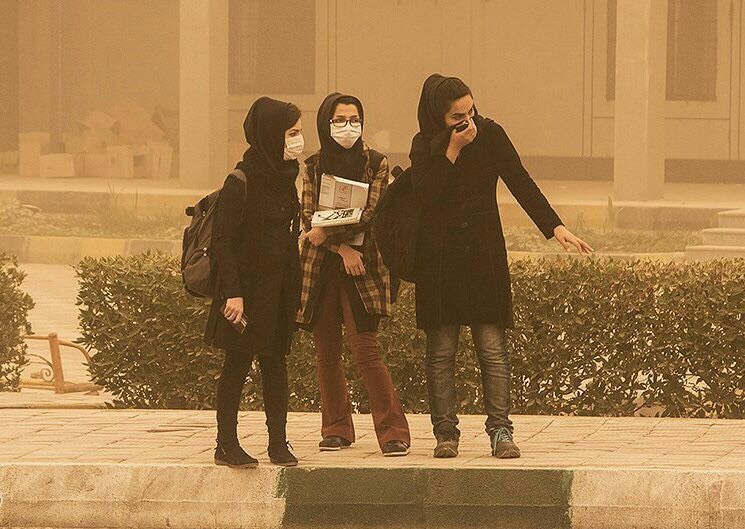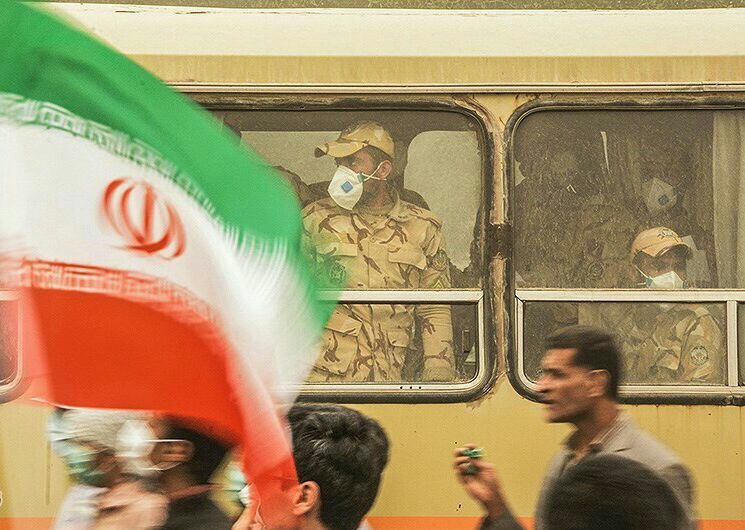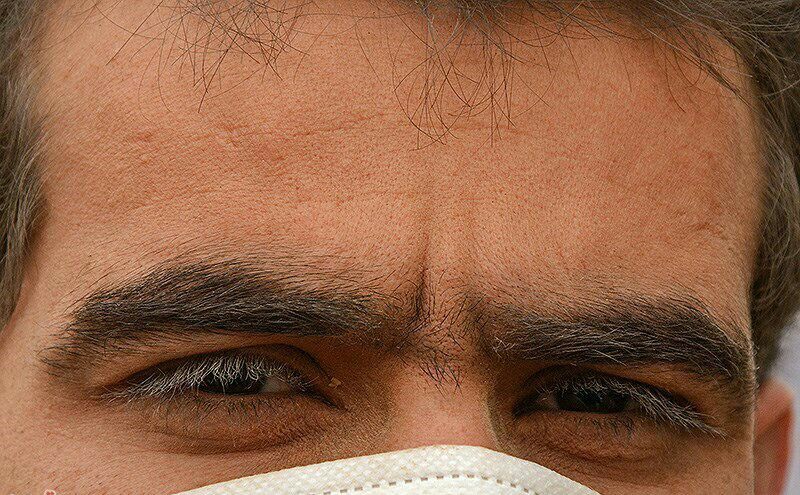The first autumn rains in Ahvaz, the provincial capital of Khuzestan in southwest Iran, foretell imminent dust storms—endless days of dust choking the city streets, leaving a film of yellow on cars and houses. They also mean thousands of hospital visits: Last year, 17,000 patients flooded the waiting room with complaints of dry coughs or symptoms of respiratory distress syndrome.
Muhammad Hussein, a 28-year-old part-time student and employee of the provincial water company, was rushed to the hospital by his wife after experiencing shortness of breath, in addition to a persistent dry cough. “I have no memory of ever going to the hospital except after my niece was born,” he told me. “But suddenly I felt like I could no longer breathe, it felt fatal.” He said the symptoms went away within days.
Videos by VICE
As emergency rooms grapple with the influx of new patients, scientists are trying to figure out exactly why this is happening. Politicians say it’s pollen from the city’s Conocarpus trees, planted in vast numbers across the city, or dust from nearby Iraq. Researchers point to other possible causes, including unregulated industries that dump waste into the air and water and rising temperatures from climate change. But with the government muzzling scientific research, solving the mystery has many barriers.
Professor Reza Panahi is on four different telephone conversations when I visit him at his office at Ahvaz University. He is speaking to a student, a professor, and two government deputies at the Provincial Office and the Environmental Protection Organization. Despite the myriad of sanctions on Iran preventing access to the purchase of research tools, Panahi has managed to get a hold of spore air samplers, devices to capture and measure the amount of airborne particles. He needs them to be up and running in Ahvaz’s eight districts before the first rain this year so he can measure the pollen in the air.
Changing weather and precipitation patterns pose new challenges to Khuzestan, but air and water pollution also exacerbate their impact. The region is home to Iran’s largest oil refinery, as well as steel, petroleum and agricultural industries, which are not stringently regulated. Industrial waste streams into increasingly dry rivers and wetlands, even in residential areas.

Young women choke on dust in Ahvaz. Image: Ali Shakiba
This has reinforced the popular sentiment in the province that Khuzestan’s wealth is extracted with little regard for the wellbeing of its citizens. Hojatollah Mirzaie, economic deputy of the labor ministry in December of 2016 reiterated a statement that is now too familiar: “Despite being rich in resources such as water, oil, petrochemicals, and gas, Khuzestan remains one of Iran’s most poorly developed regions.”
Poorly developed—and increasingly sick. The dust storms and rain are primary examples of how climate change has come to severely affect public health.
Meanwhile, officials continue to blame Conocarpus pollen for the respiratory illnesses that come with the autumn rains. Panahi has accurate statistics about trees in each region and plans to search for links between hospital visits and size of tree populations. (When I last inquired in December 2016, he said they had not yet found “conclusive evidence of a link.”) Governors and administrators routinely call for the cutting of the trees, especially after public health scares.
It has taken me a number of meetings to find Panahi—the rare researcher willing to speak publicly, and freely share information. Others agreed to discuss their work only if I was wiling to translate their articles for submission to English-language journals. One academic explains that they are extremely limited in their ability to share their results, despite being recruited by numerous organizations to conduct research. The ministries of health, oil, and power do call on local researchers to study the environmental conditions of the province, but they’re barred from publishing their findings.

Soldiers on a bus during a dust storm in 2016. Image: Ali Shakiba
“In particular areas, we’ve found rare diseases linked to industrial waste for example. But we cannot publish,” Panahi told me. “The research sponsor takes our data and says ‘thank you for your efforts, now forget what you have found and move on’.”
Khuzestan is located in the Fertile Crescent in western Asia, home to the earth’s earliest settlements and farming communities. Residents casually pass by monuments—temples, bridges, and irrigation canals—dating back thousands of years. In the last half a century, the landscape of the province has dramatically shifted from one of farming and nomadic pastoralism to gas flares and foreboding industrial plants. Khuzestan is also Iran’s oil producing core, with the first oil rigs drilled by the British in 1909.
“It’s not just water pollution and dust storms that we are grappling with—it’s water and air pollution, drought, dust and climatic shifts and there is no one comprehensive study on the combined effect of all of this together,” Panahi said, “But even observed individually, alarm bells are ringing.”
In October 2015, a study published in the journal Nature Climate Change predicted that areas around the Persian Gulf—just 60 miles south of Ahvaz—would become “uninhabitable” in the next 100 years due to rising temperatures. “It’s as if human settlement began here and will end here first,” one agricultural researcher working in northern Khuzestan told Motherboard.
Summer temperatures now reach as high as 150 degrees Fahrenheit, and Ahvaz sits at the very top of WHO’s World’s Most Polluted Cities. In February, a major dust storm caused water and power outages throughout the province, including the capital. The disruptions, according to government officials, were the result of humidity levels that went as high as 97 percent, as well as the dust. Abadan, home to Iran’s largest oil refinery, and the port city Khorramshahr, were among other cities affected.
Read More: Sand Is Wiping This Tunisian Town Off the Map
By now, residents in Ahvaz know the routine of a dust storm: The air gets cooler and, to the untrained eye, it might look like rain is about to fall. But dust is on the horizon. People rush to close doors, windows, and vents of any kind. Most people in the city have a surgical mask ready in their bags. In the villages, they moisten a scarf with water and wrap it around their face. Schools have been so routinely closed due to storms in the past years that there is talk of adjusting the school year to coincide with dust season.
Air pollution is often measured by assessing levels of PM10 particles in the air. Less than 10 microns in diameter and thinner than the width of human hair, such particles can easily be inhaled and enter the lungs or bloodstream. The particles are linked to a range of illnesses from asthma to heart disease and lung cancer.
Major sources of such particles are cluster matter (such as dust and sea salt), biomaterials, shipping, industrial activity, construction, and vehicle emissions—a mammoth amount of which exists around Ahvaz. The prevalence of particulate matter can also be influenced by seasonal patterns of wind and precipitation. Mean annual PM10 concentrations in Ahvaz reach their peak at 421 µg/m3 in the month of July—over twice the concentrations found in industrial sites around Calcutta, and three times Beijing’s highest concentration. The weekly average PM10 level in the city is five times higher than the guidelines prescribed by WHO.

A cyclist crosses a bridge during a dust storm in Ahvaz. Image: Ali Shakiba
“A significant increase in frequency and the intensity of sand and dust storms has been observed in the Middle East over the past 15 years,” the World Meteorological Organization reported in June 2016. Worst hit are Iran and Kuwait. Dust storms in southwestern Iran have long occurred due to the penetration of high pressure systems in Iraq and northern Saudi Arabia, but incessant dam construction across the region and severe droughts have contributed to much higher dust volumes.
Initially, Iranian officials blamed sources of dust from Iraq and other locations outside the country, often with racially slurred language (one news organization called it “Arab Dust”). But more and more, the drying of Khuzestan’s major wetlands and rivers is one source behind worsening dust storms.
Khuzestan is home to two major wetlands: Hawrul Azim and Shadegan. A United Nations Environment Program-funded study reports that the Mesopotamian wetlands, which include Hawrul Azim in Iran and Hawrul Hoveyezeh in Iraq, have turned into a “salt encrusted desert” and are likely to disappear. Studying satellite imagery from the 1970s onwards, the report states that 90 percent of the marshlands, home to distinct wildlife, have dried.
Five major rivers also run through the province. The Karun and Dez rivers together compose the greatest surface water system in Iran. The Karun was used for shipping well into the first half of the twentieth century. Today, due to overbuilding of dams, urban wastewater, and industrial waste, the state of the river is what Mehdi Qomshi, adviser to the Khuzestan governor calls “extremely alarming.” From the city of Ahvaz alone, over 400,000 cubic meters of wastewater are drained into the Karun daily. “Karun’s head water is channeled to Isfahan while locals have no clean water to drink,” Qomshi said.
Drinking water is also a contentious matter in Khuzestan, where the wealthy buy bottled water or costly home purification systems and the poorer residents boil the yellow gray substance that often flows from their taps.

Image: Ali Shakiba
The oil ministry has admitted to playing a role in the drying of the province’s rivers and wetlands for oil exploration and extraction, but each administration blames the previous one. In September 2016, the current Iranian oil minister, Bijan Zangeneh, told an audience in Ahvaz: “People here blame the oil ministry for all the ills, but there are 18 other ministries here carrying out projects.”
While the environmental protection agency, the provincial governor’s office, and various NGOs have called for immediate action, major efforts seem far off. Panahi tells me that 550,000 hectares of the province lie in what he called a critical state—no longer usable and a major source of dust. Proposed solutions proposed include applying mulch to the surface of the soil and planting resistant greens. But, a deputy of the governor’s office told Motherboard, “We have no budget and much of these lands are privately owned, so we have no jurisdiction.”
In southern Khuzestan live the Marsh Arabs, communities who have for centuries lived around the Shatt Al Arab river and sustained themselves through date farming, fishing, and bird hunting. They were the first to bear the brunt of the coming changes.
Today, all across the riverlands of the Shatt, dry date orchards can be seen from afar. A local farmer pulls the leaves and shows me the drying specks: Fusarium wilt, a blight caused by dust and dryness. He told me of the okra and wheat fields that “grow a few centimeters and then die out.” Even during the war, he said, he produced abundant crops every year—but not so anymore.
Farming began in the Fertile Crescent roughly 10,000 years ago, but by 3800 BC, farmland began drying out. The region instead became a network of towns and cities, and thrived as a cultural and political center. Eventually the area would again metamorphose into the global heart of the energy industry. Now Iran and its neighbors are facing new a climate challenge. When the dust settles, what will the Fertile Crescent become?
Subscribe to pluspluspodcast , Motherboard’s new show about the people and machines that are building our future.




